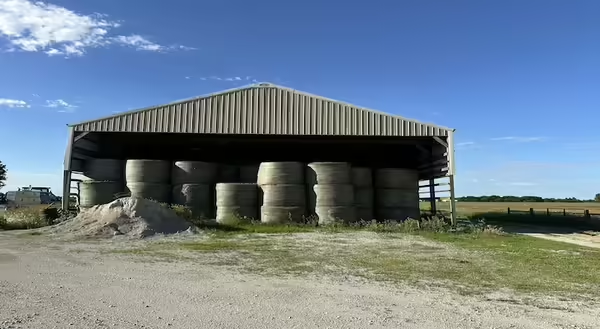
Whether you are buying hay or making it yourself, it can be expensive. Reducing the need for stored feeds is a key profitability indicator for beef cow/calf operations. However, having access to dry, quality forages can serve as an important supplement and forage replacement in times of drought or forage dormancy. Proper storage of hay prior to feeding is important to reducing waste, avoiding nutrient loss, and maintaining palatability.
Storing hay inside a well-ventilated barn will result in the least amount of loss. Humid regions and high rainfall areas are good candidates for bale storage inside. Humid areas are also prone to bales being too wet at time of harvest. Bales too high in moisture can combust and catch fire. Thus, tightly packing bales into a barn can end with a dangerous situation and loss of hay and storage structure if a bale catches fire. If you plan to store hay inside a shelter or structure, purchase a moisture/temperature probe and monitor bale moisture closely at harvest and while in storage.
When storing bales outside, several factors will influence the amount of storage loss that occurs. Among the factors you will want to be mindful of are:
• Bale Density – Tighter, more dense bales will be less permeable to water infiltration
• Annual Rainfall- Areas with more rainfall will be at greater risk for bale storage losses.
• Storage site – A well-drained site where danger of fire is limited. Do not store bales under trees or in areas where moisture is harbored.
• Bale Orientation – Avoid bales touching on the sides or rounded portions, flat ends should be firmly butted together, Run rows of bales north to south to increase sunlight exposure,
Storing hay outside can be improved in several ways. Improve the drainage of the area. Most hay loss comes from moisture wicked from the ground, not rainfall. Thus, a layer of coarse rock that will keep soil contact to a minimum is a good option. Utilizing pallets, telephone poles, or railroad ties to elevate bales from the ground can be a solution. Also, ensure bales do not touch on the sides. Leave plenty of space when rowing bales to help with ventilation. Avoid stacking bales if you are not covering with a tarp or putting in an enclosure. Tarps are a lower cost investment than sheds. If tarps are secured properly and the bottom of the bale is kept dry, expect big improvements in bale storage. Wrapping wet hay has become popular, but you can also wrap dry hay as a method to reduce loss and spoilage. Black plastic wrap is generally preferred for wrapping dry hay since it is cheaper, draws heat, and helps to evaporate condensation. Keeping moisture off and away from bales will help reduce hay storage losses.
*Originally published in Progressive Cattle magazine